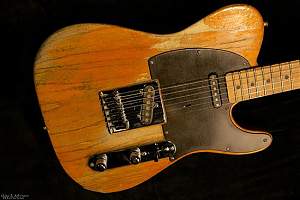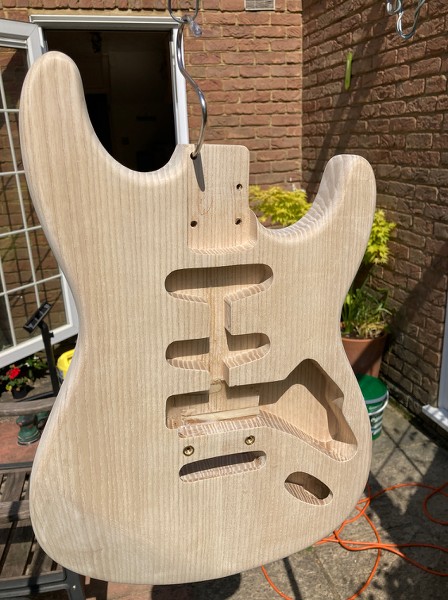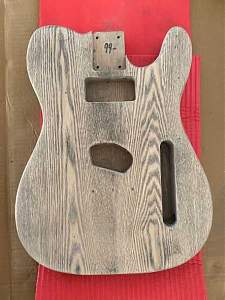A solid colour won't get you the Springsteen look as you'll miss seeing the grain pattern and it won't look anything like it (I once had a solid colour butterscotch Squier Tele and it didn't look at all convincing) .

Definitely carry on with the transparent/translucent finish ideas though as it should look great.
Whilst your body might have an ash body, there are different types of ash. It's becoming harder to get the widely spaced grain patterns used in those classic 50s and 60s Fenders, especially with that type of ash tree badly affected by ash dieback due to a fungus from Asia. A lot of the kit ash used has much closer together grain patterns. A lot has changed in the past five years, where it was easy to get a Pit Bull body with the correct style of ash figuring that you want.
A lot of the site kit photos are quite old now, so often don't represent quite what you will receive (though the current TLA-1 picture is pretty close). To get a really good Springsteen-style ash body, you'd probably need to look elsewhere and pay more and select your own body and neck from a site where each kit has its own individual picture so you can see what you are getting.
TruOil, Tung Oil, Boiled Linseed Oil. All are polymerising oils that plasticise as the set so you end up with a hard finish. There's a fair bit of boiled linseed oil in TruOil, along with a few other ingredients .
It may take a bit longer for BLO (boiled linseed oil) to set hard compared to TruOil, but I've never used BLO, so can't say exactly. And I think you are more likely to get more of a satin finish with BLO than with TruOil (which can be polished to a gloss finish if you want), but I'm happy to be corrected by people who've used it.
TruOil and BLO both have a slight yellow/amber tint and both tend to yellow more with age, so give a reasonable butterscotch finish (the 'clear' nitro available at the time was slightly amber, and it too yellowed more with age, giving the darker hues you see on the guitar today).
Good grief - the Tele that you've posted there is wonderful.
Itís either Springsteensís Esquire or someoneís very good copy of it.
I believe he bought it in 1973 and someone had already added the neck pickup and modified the wiring. So it looks (and from a practical viewpoint) is a Tele, but it does say Esquire on the headstock.
My GST-1 build was an 'American ash' body, but it's white ash, which has much closer and more regular grain lines than black ash, the type you really need for a Springsteen Tele (or any classic ash-bodied Fender).

Hi Dozy
Thanks for your thoughts - just wondering if I could explore this comment, though.
Are you saying that:
- the colour itself just wouldn't work with the grain that I've brought up; or
- light coloured/natural coloured finishes wouldn't work in general; or
I'm prepared to go with a darker stain (ie like a walnut) if that is what it takes to counter balance my strong grain.
Perhaps put another way (and a question to the forum more generally) - is there a thought process behind matching grain to certain finishes (or is this entirely subjective, in which case my head is about to explode with all the possibilities right now - guitars are such works of art and I want all of them now in all colours).
I've been going through the Feast Watson colours and have narrowed it down to about 6 at the moment
I think the only certainty I have now, is that I'd like to do a semi-acoustic in a deep cherry colour and a sunburst tele (but both are for another time, I think unless I've kinda hit a point of "no return" with this one and I might as well "go for broke" and use it as a platform to try a few things). On that note - if I don't like what I've done, to what extent can I return to "ground zero" - ie just the ash and grain filler - presumably by a LOT of sanding?
Sorry for all the N00by questions
I think itís more that to achieve the actual Coolangatta Gold colour, you need a fairly light coloured wood to apply it to. From the photo of the body, the overall effect will end up looking a lot darker and more of a light brown than a yellow/gold finish. But until you apply it, youíll never know.
Youíve said it looks darker in the photo than in real life, so maybe you can either take a better photo or edit the contrast/brightness/colour balance of the original to get it looking closer to reality. This would make it easier to comment on the likely outcome of different colours on the body.
A flat-bodied guitar like a Tele is reasonably easy to sand the finish off using a random orbital sander. That can do most of the sides as well. If you have an oscillating spindle sander, then that will do the inside curves, otherwise thatís the most time-consuming part and will have to be hand sanded.
Thanks, very much, Simon (as ever, thanks for your thoughts and willingness to help)
I understand what you are saying about re: lightness of underlying wood and how it interplays with the CG.
I'm not committed to that colour and I'll return it (small cost of return postage and I'll have some store credit for future projects).
I've had another go at photographing in better light and I've given it another good sand. I think that the colour/contrast is about right in this image. But to me the overall impression is "dark".

That looks more promising.
There seem to be a few areas where there still seems to be some excess Timbermate on the surface, making those areas a bit darker than they could be. I wouldn't worry too much about the bits that will be under the scratchplate, and it may just be the natural grain pattern that you can't do much about, but I'd see what a bit more sanding could do in those areas, just to try and get as even a look as possible.
If you want to try the DingoTone on it, then it could work reasonably well, though I still think it will look a bit darker overall than in the DT example pictures. Maybe try an application just on the back to a) see what it looks like and b) see how well it dries. Easy enough to sand back a single application with a sander on a flat surface if necessary.
Sometimes you just have to go for it and try things out. There's almost always a way to recover the situation if it goes wrong.